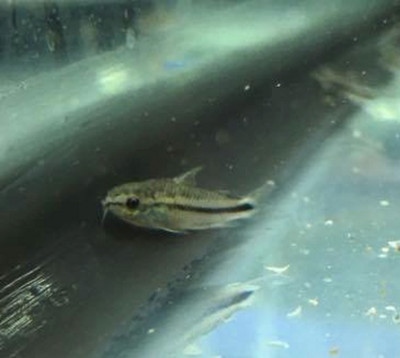Pygmy Corydoras
Posted by Max Gandara on on 8th Jun 2025
Pygmy Corydoras: Tiny Catfish with Giant Personality
In the world of freshwater nano fish, few species are as endearing, peaceful, and lively as the Pygmy Corydoras (Corydoras pygmaeus). Despite their small size, these miniature bottom-dwellers offer plenty of action, cuteness, and community tank compatibility.
Whether you're a beginner looking for hardy fish or a seasoned aquascaper designing a lush nano tank, the Pygmy Cory is a must-have species.
Species Snapshot
-
Scientific Name: Corydoras pygmaeus
-
Common Names: Pygmy Cory, Pygmy Catfish
-
Origin: South America (Brazil, Ecuador, Peru)
-
Adult Size: 0.75–1 inch (1.9–2.5 cm)
-
Lifespan: 3–5 years (can reach 6+ with excellent care)
-
Temperament: Peaceful, active, social
-
Tank Zone: Bottom to midwater (unlike most corys)
Appearance: Small, Sleek, and Silvery
The Pygmy Corydoras may be tiny, but they’re striking in the right environment.
-
Body: Slender and torpedo-shaped
-
Color: Silvery-gray with a bold black horizontal stripe from snout to tail
-
Fins: Clear and delicate
-
Sexing: Females are rounder and slightly larger than males
Their subtle colors shimmer beautifully under soft lighting, especially in planted aquariums with darker substrates.
Behavior: Not Just Bottom Dwellers!
Unlike most Corydoras, Pygmy Cories frequently swim in the middle levels of the tank in small schools — more like tetras than traditional catfish. They’re highly social and should always be kept in groups of 8–10 or more.
You’ll often see them:
-
Darting around in synchronized bursts
-
Shoaling midwater with their group
-
Gently scavenging the substrate for food
? Fun Fact: They occasionally swim to the surface for a gulp of air — a natural trait, not a sign of distress.
Ideal Aquarium Setup
Because of their small size and peaceful nature, Pygmy Corys are ideal for nano tanks, planted aquascapes, and peaceful community aquariums.
Minimum Tank Size:
-
10 gallons (though 15–20 gallons is better for a large school and more tankmates)
Water Conditions:
-
Temperature: 72–78°F (22–26°C)
-
pH: 6.0–7.5
-
Hardness: Soft to moderate
-
Water Flow: Gentle; they dislike strong currents
Substrate & Décor:
-
Fine sand or very smooth gravel (to protect their sensitive barbels)
-
Plants: Java fern, anubias, dwarf sagittaria, floating plants
-
Décor: Driftwood, leaves, or coconut hides for cover
-
Lighting: Low to moderate
Use a sponge filter or low-flow filter to protect these tiny fish from strong suction and current.
Tankmates: Nano Community Stars
Pygmy Corydoras are perfect community fish, provided their tankmates are equally peaceful and small.
Ideal Tankmates:
-
Neon, ember, or green neon tetras
-
Chili rasboras
-
Celestial pearl danios
-
Dwarf gouramis (calm ones)
-
Otocinclus
-
Shrimp (like cherry or Amano)
-
Snails (nerite, mystery)
Avoid:
-
Large or aggressive fish (like angelfish or cichlids)
-
Fast, boisterous species that might outcompete them for food
Diet: Tiny Fish, Big Appetites
Pygmy Cories are omnivores and will happily graze on leftover food — but they still need their own meals.
Best Food Options:
-
Sinking micro pellets
-
Repashy gel food
-
Frozen/live foods: Daphnia, bloodworms, baby brine shrimp
-
Vegetables: Blanched zucchini or spinach (in small bits)
Feed once or twice daily in amounts they can finish within a few minutes. Because they're small and shy, be sure food reaches the bottom and isn’t taken by mid- or top-level fish.
Breeding Pygmy Corydoras
Breeding is possible in a well-maintained home tank with a little preparation.
Breeding Setup:
-
Slightly cooler water changes (~5°F lower) often trigger spawning
-
Provide fine-leaved plants or glass walls for egg deposition
-
Use a dedicated breeding tank for better control
-
Eggs hatch in 3–4 days
Feed fry infusoria or powdered fry food until they can eat baby brine shrimp.
? Note: Pygmy Cory fry are delicate — keep the water extra clean and well-oxygenated.
Health & Care Tips
Pygmy Cories are generally hardy but sensitive to poor water quality and injury from rough substrate.
Common Issues:
-
Barbel infections or erosion from sharp gravel
-
Ammonia/nitrite sensitivity
-
Fungal infections on eggs or wounds
Preventive Care:
-
Use sand substrate
-
Perform regular water changes (25–30% weekly)
-
Keep water parameters stable
-
Quarantine new tankmates
Why Choose Pygmy Corydoras?
-
✅ Super peaceful and social
-
✅ Perfect for nano tanks and planted aquascapes
-
✅ Unusual swimming behavior — not just bottom huggers!
-
✅ Easy to feed and care for
-
✅ Suitable for beginners and experienced hobbyists
Final Thoughts
The Pygmy Corydoras proves that great things come in small packages. Their peaceful nature, unique schooling habits, and tiny size make them a joy to watch and easy to keep in small or large tanks alike. Whether in a bustling nano setup or a quiet planted scape, these miniature catfish are sure to win your heart.

